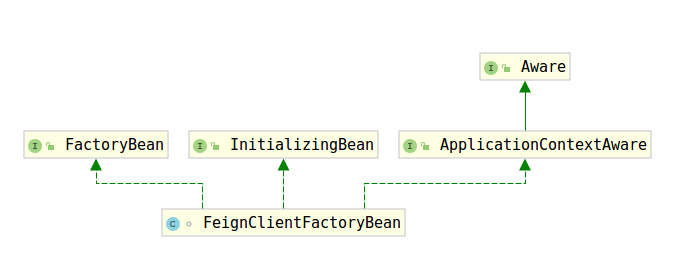今天就跟大家聊聊有关Feign中FeignClientFactoryBean的作用是什么,可能很多人都不太了解,为了让大家更加了解,小编给大家总结了以下内容,希望大家根据这篇文章可以有所收获。

图1
其属性如List-1所示,这些属性的值都是在FeignClientsRegistrar中设置的。
List-1
class FeignClientFactoryBean
implements FactoryBean<Object>, InitializingBean, ApplicationContextAware {
/***********************************
* WARNING! Nothing in this class should be @Autowired. It causes NPEs because of some
* lifecycle race condition.
***********************************/
private Class<?> type;
private String name;
private String url;
private String contextId;
private String path;
private boolean decode404;
private ApplicationContext applicationContext;
private Class<?> fallback = void.class;
private Class<?> fallbackFactory = void.class;
...由于实现了FactoryBean接口,我们来看最重要的getObject()方法,如List-2,getTarget方法中首先从Spring上下文中获取FeignContext。FeignContext是在FeignAutoConfiguration中注册到Spring容器中的,如List-3所示,会将spring容器所有的FeignClientSpecification放入到FeignContext中,FeignClientSpecification在Feign源码分析之EnableFeignClients中讲过,即EnableFeignClients的defaultConfiguration。
List-2
@Override
public Object getObject() throws Exception {
return getTarget();
}
<T> T getTarget() {
FeignContext context = this.applicationContext.getBean(FeignContext.class);
Feign.Builder builder = feign(context);
...List-3
public class FeignAutoConfiguration {
@Autowired(required = false)
private List<FeignClientSpecification> configurations = new ArrayList<>();
@Bean
public HasFeatures feignFeature() {
return HasFeatures.namedFeature("Feign", Feign.class);
}
@Bean
public FeignContext feignContext() {
FeignContext context = new FeignContext();
context.setConfigurations(this.configurations);
return context;
}
...List-2中,得到FeignContext后,调用feign方法,从FeignContext中获取Encoder、Decoder、Contract,其实内部是从spring容器中获取的,得到Feign.Builder。
我们可以实现RequestInterceptor接口,之后交给Spring容器,feign会自动加上这个拦截器,这个的实现也在FeignClientFactoryBean中,在configureUsingConfiguration方法中,如下List-4
List-4
Map<String, RequestInterceptor> requestInterceptors = context
.getInstances(this.contextId, RequestInterceptor.class);
if (requestInterceptors != null) {
builder.requestInterceptors(requestInterceptors.values());
}List-4中的context.getInstances()方法内部是如何实现的呢。来看下FeignContext的父类NamedContextFactory,List-5中的setConfigurations方法在List-3中调用,在构造FeignContext的时候调用的。
List-5
public void setConfigurations(List<C> configurations) {
for (C client : configurations) {
this.configurations.put(client.getName(), client);
}
}List-6中
getConext方法获取ApplicationContext,之后从该ApplicationContext中获取bean
getConext方法中,如过name对应的ApplicationContext不存在,则调用createContext方法进行创建
AnnotationConfigApplicationContext.register方法把配置类注册到ApplicationContext中,还设置了AnnotationConfigApplicationContext的parent为当前Spring上下文,这样当在AnnotationConfigApplicationContext中获取不到bean时,就会从父ApplicationContext中获取
List-6
public <T> T getInstance(String name, Class<T> type) {
AnnotationConfigApplicationContext context = getContext(name);
if (BeanFactoryUtils.beanNamesForTypeIncludingAncestors(context,
type).length > 0) {
return context.getBean(type);
}
return null;
}
protected AnnotationConfigApplicationContext getContext(String name) {
if (!this.contexts.containsKey(name)) {
synchronized (this.contexts) {
if (!this.contexts.containsKey(name)) {
this.contexts.put(name, createContext(name));
}
}
}
return this.contexts.get(name);
}
protected AnnotationConfigApplicationContext createContext(String name) {
AnnotationConfigApplicationContext context = new AnnotationConfigApplicationContext();
if (this.configurations.containsKey(name)) {
for (Class<?> configuration : this.configurations.get(name)
.getConfiguration()) {
context.register(configuration);
}
}
for (Map.Entry<String, C> entry : this.configurations.entrySet()) {
if (entry.getKey().startsWith("default.")) {
for (Class<?> configuration : entry.getValue().getConfiguration()) {
context.register(configuration);
}
}
}
context.register(PropertyPlaceholderAutoConfiguration.class,
this.defaultConfigType);
context.getEnvironment().getPropertySources().addFirst(new MapPropertySource(
this.propertySourceName,
Collections.<String, Object>singletonMap(this.propertyName, name)));
if (this.parent != null) {
// Uses Environment from parent as well as beans
context.setParent(this.parent);
// jdk11 issue
// https://github.com/spring-cloud/spring-cloud-netflix/issues/3101
context.setClassLoader(this.parent.getClassLoader());
}
context.setDisplayName(generateDisplayName(name));
context.refresh();
return context;
}看完上述内容,你们对Feign中FeignClientFactoryBean的作用是什么有进一步的了解吗?如果还想了解更多知识或者相关内容,请关注亿速云行业资讯频道,感谢大家的支持。
亿速云「云服务器」,即开即用、新一代英特尔至强铂金CPU、三副本存储NVMe SSD云盘,价格低至29元/月。点击查看>>
免责声明:本站发布的内容(图片、视频和文字)以原创、转载和分享为主,文章观点不代表本网站立场,如果涉及侵权请联系站长邮箱:is@yisu.com进行举报,并提供相关证据,一经查实,将立刻删除涉嫌侵权内容。
原文链接:https://my.oschina.net/u/2518341/blog/3113900